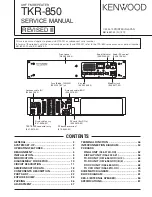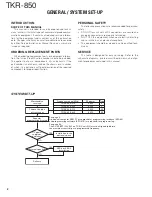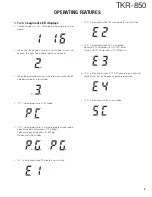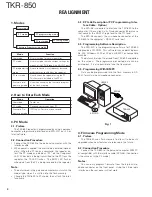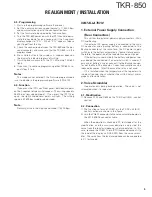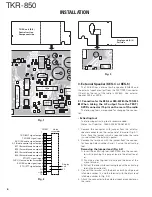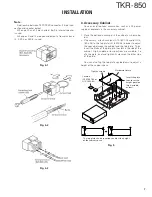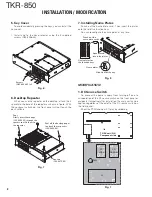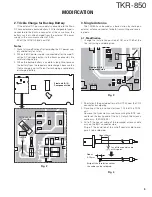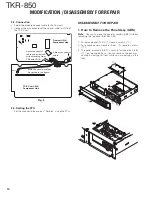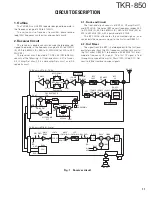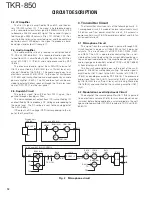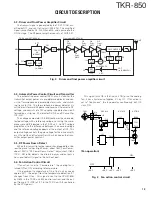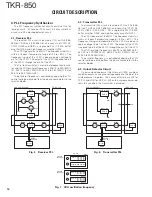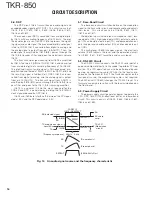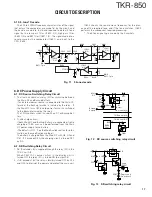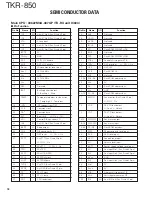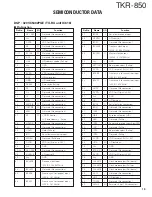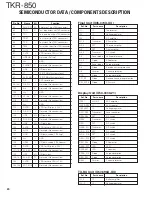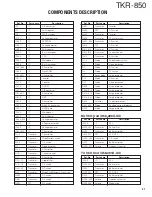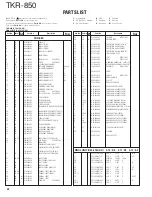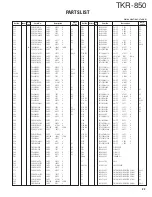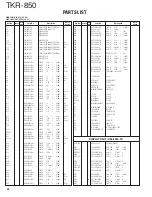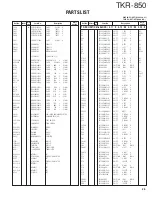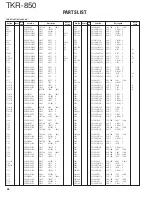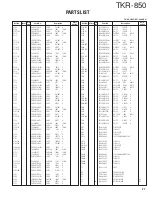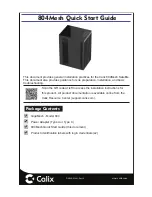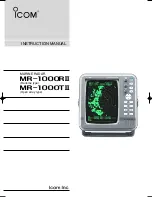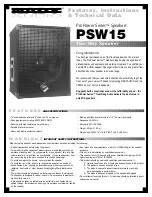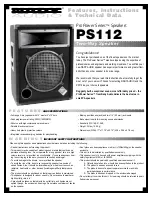
TKR-850
12
2-3. IF Amplifier
The first IF signal is amplified by Q2 and Q3, and then en-
ters IC9 (FM system IC). The signal is heterodyned again
with a second local oscillator signal (44.395MHz) with in IC9
to become a 455kHz second IF signal. The second IF signal is
fed through a 455kHz ceramic filter, CF1 (Wide), CF2 (Nar-
row) to further eliminate unwanted signal, and the quadrature
detection circuit FM-detects the signal to produce a base-
band signal and output it from pin 11.
2-4. Audio Amplifier
The audio amplifier circuit is located in control section of
TX-RX unit (X57-696 B/2). The recovered audio signal ob-
tained from IC9 is amplified by IC608, input to the AINR ter-
minal of CODEC IC (IC614), and audio processed by DSP
(IC618).
The processed audio signal from AOUTR terminal of
IC614 is amplified by IC619 (B/2) to a sufficient level, anti-
aliasing filtered by IC619 (A/2). The audio signal goes to an
electronic volume (IC615) V3/V4, to the input of multiplexer
IC (IC622), and is amplified to drive a loudspeaker by an audio
power amplifier (IC629). The 4W audio output can be pro-
vided to external 4 ohms speaker through the 15-pin test con-
nector “SPO, SPG” on the rear panel.
2-5. Squelch Circuit
The output signal from IC9 enters FM IC again, then
passed through a band-pass filter.
The noise component output from IC9 is amplified by Q7
and rectified by D5 to produce a DC Voltage corresponding to
the noise level. The DC voltage is sent to the analog port of
the CPU (IC604).
IC9 outputs a DC voltage (RSSI) corresponding to the in-
put of the IF amplifier.
3. Transmitter Circuit
The transmitter circuit consists of the following circuits : 3-
1 microphone circuit, 3-2 modulation level adjustment circuit,
3-3 driver and final power amplifier circuit, 3-4 automatic
power control circuit, 3-5 RF power down detect, and 3-6 fan
action control circuit.
3-1. Microphone Circuit
The signal from the microphone is passed through AGC
circuit located in display unit (X54-333), so that it does not
saturate. This circuit consists of IC501, D501, D502, Q501,
and Q502. The AGC is operated by controlling the + and –
side levels of amplitude using the current obtained by posi-
tive and negative detection of the amplified audio signal. The
audio signal goes to control section of TX-RX unit (X57-696 B/
2) from display unit (X54-333).
The transmit audio signal goes to the input of the multi-
plexer IC (IC605) for microphone muting. The audio signal is
amplified by IC610, input to the AINL terminal of CODEC IC
(IC614), and audio processed by DSP (IC618). The processed
audio signal from the AOUTL terminal of IC614 is amplified
by IC616 (A/2) to a sufficient level, anti-aliasing filtered by
IC616 (B/2), and amplified by the summing amplifier IC611
(A/2).
3-2. Modulation Level Adjustment Circuit
The output of the summing amplifier IC611 (A/2) is passed
to an electronic volume (IC615) for maximum deviation ad-
justment before being applied to a varactor diode in the volt-
age controlled oscillator (VCO) A2 located in TX-RX unit (X57-
696 A/2).
TXRX unit (X57 B/2): CONTROL
MIC
CODEC IC
MO
SW
MIS
TA
TXO TXI
MB
D-SUB
TD
DAC
SW
TDS
TAS
AINL
AOUTL
SW
MIC JACK
J601
Display unit
(X54 B/2)
AMP
ATT
DET
MIC
Display unit (X54 A/2)
IC501(A/2)
Q501,502
D501,502
VR501
IC605 (A/2)
IC610
IC614
IC616
(B/2)
IC616
(A/2)
IC605 (B/2)
IC615
AMP
AMP
IC611
(A/2)
AMP
LPF
Fig. 2
Microphone circuit
CIRCUIT DESCRIPTION

